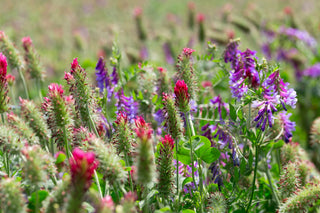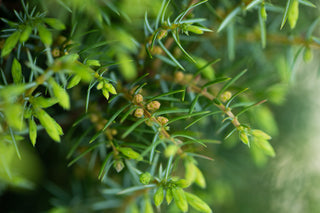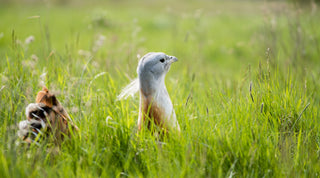CREATING
BIODIVERSITY
Once a patch of nettles, now a thriving ecosystem with flora and fauna.
Anyone who has taken a tour at Downton Distillery will know that Hugh’s passion for the natural world both flora and faunais woven into every visit. That same commitment to biodiversity is reflected in the land surrounding the distillery, which has been carefully rewilded to support native species.
When we relocated the distillery, one of our key objectives was to transform a disused piece of land into a thriving botanical garden a space where we could grow our own botanicals for distillation while also using it as an educational tool for summer tours.
The land centred around a young walnut tree proved to be ideal for cultivation, with rich and well-drained soil. In facing south, it has full sun exposure throughout the summer. However, it also presented challenges, as harsh winds from the west sweep across the Downs, testing the resilience of the plants. Over the past two years, we have carefully nurtured and developed this garden, cultivating a diverse selection of botanicals, including angelica, salvias, lavender, chamomile, lemon thyme, thyme, rosemary, woodruff, yarrow, fennel, oregano, bay, wormwood, lemon verbena, lovage, borage, and red clover.
We've also introduced a variety of junipers. Juniperus communis, Blue Carpet, and Skyrocket alongside cone flowers, ox-eye daisies, and alfalfa (lucerne). This garden is more than just a growing space; it’s a living, breathing ecosystem, supporting biodiversity, sustainability, education, while enriching the spirits we craft.
sanctuary
The botanical garden has been carefully designed to create an insect haven, fostering a rich, biodiverse ecosystem teeming with pollinators, beneficial insects, and small wildlife. A carefully curated mix of aromatic herbs, wildflowers, and junipers ensures a continuous supply of nectar, shelter, and food sources throughout the seasons. Lavender, salvias, chamomile, and lemon verbena attract bees and butterflies, while borage, red clover, and yarrow provide essential sustenance for honeybees and bumblebees. The hummingbird hawk-moth, with its remarkable hovering flight, is particularly drawn to verbena, red valerian and mullein. While coneflowers and alfalfa (lucerne) nourish painted lady and common blue butterflies, adding vibrant life to the space. Additionally, red clover and alfalfa improve our soil health, their deep roots helping to recondition and enrich the earth.
The garden also promotes natural pest control, with ladybirds, hoverflies, and lacewings thriving among yarrow, fennel, and oregano, feeding on aphids and maintaining plant balance. Meanwhile, wormwood and bay act as natural deterrents against harmful insects. Beyond its role as an insect sanctuary, the garden’s junipers (Juniperus communis, Blue Carpet, and Skyrocket) provide vital shelter for toads, wrens, young pheasants and leverets from the Downs. Through this thoughtful design, the garden has become a balanced, sustainable environment, where pollinators, natural predators, and wildlife flourish in harmony.
A Haven for Wings
In 2021, the fifth Birds of Conservation Concern review was published, highlighting species at risk across the UK using a traffic light system: red for the most threatened, amber for those in decline. Remarkably, our small patch of rewilded land is now home to five red-listed and seven amber-listed bird species.
Thanks to the varied habitats created through planting native wildflowers, hedgerows, and allowing nature to reclaim space, bird diversity has flourished. Skylarks now sing overhead, joined by corn buntings, yellow hammers, finches, warblers, and tits moving between the plants and hedgerows. If you’re especially lucky, you might even hear wild quail calling to each other through the undergrowth.
What was once a forgotten and overgrown corner has become a thriving refuge living proof that even small-scale conservation can have a powerful impact.















